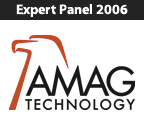 A panel of ID industry experts provided predictions for 2006. One of these glimpses into the future will appear here each day during December.
A panel of ID industry experts provided predictions for 2006. One of these glimpses into the future will appear here each day during December.
By Dave Ella, Vice President of Products, AMAG Technology
The security industry is seeing an increasing number of changes in what used to be the access control industry and is now security management. This is being driven almost entirely by technology – including smart cards, biometrics, the LAN / WAN and VPN (Virtual Private Network), digital video, and advanced video analytics among others.
The most important changes include the movement of almost all security systems to the LAN and WAN, and the new integration opportunities this has presented. Almost every access control system that AMAG sells incorporates some form of integration, whether it is with one of the leading digital video brands, intercom or intrusion panels.
 Web technologies present a whole range of new opportunities. Many forward-thinking organizations are consolidating their security for all locations into a single integrated system across a VPN. AMAG allows customers to write their own integrations using secure XML web services.
Web technologies present a whole range of new opportunities. Many forward-thinking organizations are consolidating their security for all locations into a single integrated system across a VPN. AMAG allows customers to write their own integrations using secure XML web services.
Biometric technology is now mature, reliable and cost-effective. The major access control providers integrate biometric enrollment into their head-end software and smart card encoding. Customers do not want a completely separate database for biometrics.
Companies have to move very quickly to stay ahead of market expectations for new technology. Those who can stay ahead will prosper. Aggressive business models that are committed to the changing technologies will provide a road map for companies to follow. AMAG’s map for the next three years anticipates even greater changes.
Visit AMAG on the web at www.amag.com.

The pinstriped lines of barcodes past are going the way of the vinyl LP – at least for many applications. Instead of the staid black-and-white bars, you are likely to find a chaotic looking area of scrambled dots. Thanks to the advances in tracking technology, barcodes have come a long way since their introduction in the early 1950s.
The barcode’s evolution is linked with society’s need for increased security and data storage. Hot on the heels of first-generation linear barcodes, the new breed of two-dimensional (2D) barcodes are less likely to fail and are capable of holding much more information than their predecessors.
The battle in the supply chain …
But the barcode, in general, is facing competition for a more ‘advanced’ technology, RFID (radio frequency identification technology). RFID is getting the most press, because it holds the promise of improved operations via the capturing of information throughout the supply chain via wireless “readers” and tags that don’t require line-of-site scanning.
The problem with RFID remains the relatively higher cost of readers and tags. Upgraded barcode technology, on the surface, seems more financially feasible. It’s cheaper to upgrade to 2D than to RFID, and you get a system more effective, sophisticated and secure than its predecessor.
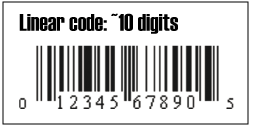 2D bar codes carry more data in the same amount of space to meet the increasing demand on the part of suppliers, distributors and retailers about products and product movement along the supply chain, says Jonathan Palmer, a professor at William and Mary College in Virginia, who studies the technology. Because they are cheaper to transition to from 1D than RFID, many companies in the retail, supply chain, shipping and tracking industries are taking them seriously.
2D bar codes carry more data in the same amount of space to meet the increasing demand on the part of suppliers, distributors and retailers about products and product movement along the supply chain, says Jonathan Palmer, a professor at William and Mary College in Virginia, who studies the technology. Because they are cheaper to transition to from 1D than RFID, many companies in the retail, supply chain, shipping and tracking industries are taking them seriously.
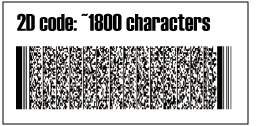 “2D technology gives you 80% of the bang for 20% of the buck,” says Alan Melling, senior director of EPC Solutions for Holtsville, New York-based Symbol Technologies, who has 30 years’ experience working with barcode technology.
“2D technology gives you 80% of the bang for 20% of the buck,” says Alan Melling, senior director of EPC Solutions for Holtsville, New York-based Symbol Technologies, who has 30 years’ experience working with barcode technology.
Trading pinstripes for precision isn’t free, which is why companies are wracking their brains, wondering if they should even bother with 2D. As several executives suggested, it’s at least worth a cursory investigation.
2D: “It’s not your father’s barcode”
The term “2D” doesn’t refer to a single, specific barcode symbology. Rather, it refers to a new breed of technology. Several dozen companies make their version of 2D barcodes, many of which are public domain. The most common standardized symbology is PDF417, developed by Symbol Technologies in 1990. PDF417 packs up to 1,800 characters in a small space, says a Symbol spokesman. Other sources warn, however, that while the specification suggests this number is possible, it is difficult to obtain this level of compaction – thus a number around 1,000 characters may be more realistic.
2D barcodes use a variety of methods to fit more data into that same amount of space, adds Mr. Palmer. They utilize the horizontal and vertical spaces (as opposed to the horizontal-only reads of traditional of bar codes) through smaller matrix designs to allow more data to be imprinted on the 2D barcode.
“The additional data also allows room for better error checking,” Mr. Palmer adds, “so the reading accuracy (is) enhanced.”
2D in the real world
There are many applications for which 2D barcodes have an advantage over simple linear codes. At shipping giant UPS, the need for a more sophisticated barcode grew as the shipping company expanded, says Donna Barrett, technology public relations manager for the Atlanta-based company.
About a decade ago, UPS grew so big that it needed a bigger code that could hold more and different information than the traditional barcode, Ms. Barrett says. Packages needed to have at least one omni-directional code as they moved through the package sorting facilities. So UPS introduced the “MaxiCode” – a second-generation code. The new barcodes hold up to 248 characters, and are used in conjunction with two linear barcodes on all packages that go through the supply chain. While scanning a single linear code is cheaper, “when you’re dealing with 14.1 million packages a day, redundancy is a good thing,” Ms. Barrett says.
If you’re not UPS, and readability of millions of supplies isn’t an issue, your institution may want to reconsider whether the upgrade to 2D is necessary, says Jake Jacobs, senior vice president of sales at Arthur Blank & Co., whose clients include major gift-card manufacturers.
Improvements in 1D barcodes have also occurred
Over the last two decades, 1D barcodes have enjoyed tremendous improvements, Mr. Jacobs says. Most 1D or traditional barcodes look nothing like their vintage relatives – they use much more durable, high-resolution ink and can hold a greater amount of data, adds Keith Goldstein, also of Arthur Blank & Co.
“The challenge that we all have with 2D barcode acceptance is the integration,” says Mr. Jacobs. “It’s a huge, multi-million dollar overhaul, to change readers to accept 2D barcodes and the retailers want to know if the ROI is worth it,” or whether the cost clearly outweighs the benefits.
Perhaps the biggest benefit is the fact that sticking to the tried and true doesn’t require a huge financial overhaul – you can still use existing equipment. “Because barcodes came out many years ago, there’s a very strong infrastructure that will read 1D, but not 2D,” Mr. Goldstein says. Thus, there isn’t a lot of demand for 2D barcodes among ABCO’s clients.
2D versus RFID
Is it worth it to invest in 2D when the future’s slated for RFID? That’s one of the biggest questions from those exploring new technologies in a world where keeping tabs on goods is becoming increasingly complex. The answer, it seems, depends on the needs of your particular institution.
“Both were designed to solve the problem of supply chain visibility,” Mr. Melling says. Upgrading to either will cost you money – but upgrading to RFID will cost you more, he adds.
Neither Mr. Melling nor his colleagues would provide the cost for a company to make the upgrade, although they said it may include new reader systems, software and handhelds that support 2D barcodes as well as 1D barcodes.
“The handheld scanners for 2D that I have seen range in price from $400 - $1200 and readers that would be placed on a production line start at about $2000,” says Mr. Palmer, who says he has studied the costs and benefits of the potentially competing technologies. “The printers are not much more expensive than traditional ones, starting at about $600, and the software can be had for $200 at the low end.”
The larger expense, Mr. Palmer says, is deciding what additional information is needed for the bar code and what this will mean for changing processes and databases.
Compared with RFID, printing 2D labels for packages cost just pennies. RFID tags remain significantly higher in cost, but the price comes with a major advantage – RFID doesn’t require line-of-site readers. Furthermore, if you’re working with a mass retailer that is converting to RFID, such as Walmart, you’re expected to upgrade.
The investment in RFID is worthy, says Mr. Melling, if it helps you save money in the long run. “If I can reduce holding inventory by 10%, it justifies the investment.”
Concluding thoughts …
Still, 2D is the optimum technology for a growing number of mediums because it saves time and money, and boasts increasing reliability over its predecessor. One application where 2D is beneficial is within state-issued IDs, Mr. Melling says. Driver’s licenses equipped with 2D are especially helpful to police officers. Because the barcodes hold a lot of information, officers don’t have to hold up traffic when giving out tickets or warnings. Instead, they can scan the information immediately instead of calling in a license number over a voice network.
To quell the whole RFID v. 2D debate, Mr. Melling recommends potential investors ask themselves the following question: “Do I see myself using RFID in the next five years? If so, then skip 2D.”
 Following on the heels of its acquisition of Diebold’s card system business earlier this year, CBORD has acquired the merchant discount membership business from Student Advantage. Included in the purchase are the existing member base, more than 20,000 pre-arranged participating merchant relationships, and the Student Advantage name. Not included is the SA Cash payment card business which will remain with Student Advantage founder Ray Sozzi.
Following on the heels of its acquisition of Diebold’s card system business earlier this year, CBORD has acquired the merchant discount membership business from Student Advantage. Included in the purchase are the existing member base, more than 20,000 pre-arranged participating merchant relationships, and the Student Advantage name. Not included is the SA Cash payment card business which will remain with Student Advantage founder Ray Sozzi.
According to CBORD EVP Bruce Lane, “we anticipate that schools with and without (other CBORD products) will take part in the program.” We have the ability (widespread campus relationships and sales presence) to project it out into the marketplace.”
In a phone interview with the CR80News editor, Mr. Lane seemed especially excited about Student Advantage’s co-branding program. For the past year and one-half, SA has offered a program to campuses where, in return for signups, the campus gets a part of the enrollment fee for the effort.
Says Mr. Lane, “schools are usually looking at cards as outflow but the co-brand is a proven way for campuses to earn income.”
CBORD® Announces Acquisition of Student Advantage® Membership Business
Deal adds important new service offering to CBORD’s campus card product line
Ithaca, New York and Boston, November 9, 2005– The CBORD Group, Inc., one of the world’s leading suppliers of campus card, housing, and foodservice management systems to colleges and universities, today announced that it has acquired Student Advantage, LLC, a subsidiary of RVS Ventures, Inc. Student Advantage is the purveyor of the nation’s largest student discount program, serving hundreds of thousands of student cardholders. The acquisition provides CBORD with a well-known university-endorsed consumer brand to augment its campus card and closed-loop payment systems to universities in the U.S., Canada, and abroad.
Bruce Lane, Executive Vice President of CBORD, said, “We are very excited to add the student marketing expertise that is the hallmark of Student Advantage to the services we offer our customers. Collectively, we will now have the added value that Student Advantage brings to students, parents, and university administrators.”
For more than a decade, hundreds of universities across the U.S. have worked with Student Advantage to market the membership program to their incoming students. Recently, Student Advantage launched a University ID co-branding initiative whereby a university can add the benefits of Student Advantage discounts directly to the University ID. CBORD will seek to provide the Student Advantage University ID program to the more than 1,000 universities it currently serves with its Odyssey PCS™ and CS Gold® campus card and housing and other management systems. In addition, Student Advantage will continue to be system neutral and available to all universities, regardless of which campus card system is being used.
Ray Sozzi, President of RVS Ventures, added, “We have seen a great demand for the University ID co-branded product from students and administrators alike, following the success of our initial launches. CBORD’s breadth and depth of relationships will allow for a dramatic acceleration in our national rollout, specifically to the more than six million students served by CBORD’s systems.”
The SA Cash off-campus payment system was not included in the transaction, and remains part of RVS Ventures.
CBORD is headquartered in Ithaca, New York, with offices in Farmington, New York; Green, Ohio; Waco, Texas; Cypress, California; and Sydney, Australia. Student Advantage, located in Boston, Massachusetts will operate as a subsidiary of CBORD.
About The CBORD Group, Inc.
The CBORD Group, Inc., founded in 1975, is marking thirty years of service to the campus-wide needs of higher-education facilities. CBORD works with a wide variety of clients and markets, providing cashless and ID card privilege control systems, housing management systems, Webfood online ordering service, and the Student Advantage discount membership program. In addition, CBORD serves thousands of chain restaurants, hospitals, universities, supermarkets, and gaming facilities with its suite of foodservice, catering, and nutrition software products. The CBORD Group has customers in the U.S., Canada, Europe, the Middle East, and Australia. To learn more about CBORD, visit us at www.cbord.com.
About Student Advantage, LLC
Student Advantage, LLC is a leading integrated media and commerce company focused on the higher education market. Student Advantage works with hundreds of colleges, universities, and campus organizations and more than 20,000 discount locations to develop products and services enabling students to make purchases less expensively around campus, across the country, and online. The Company reaches its consumer base offline through the Student Advantage Discount Card and online through its www.studentadvantage.com website.
 Two years ago, CR80News conducted a quantitative survey of campus card banking partnerships in an attempt to put some numbers to trend . Our editors surveyed seven financial institutions that were determined to be actively involved in the market, offering banking services via the campus ID card. This month we endeavored to update this survey to provide a current picture of the market and investigate whether this often-discussed application is on the rise or decline.
Two years ago, CR80News conducted a quantitative survey of campus card banking partnerships in an attempt to put some numbers to trend . Our editors surveyed seven financial institutions that were determined to be actively involved in the market, offering banking services via the campus ID card. This month we endeavored to update this survey to provide a current picture of the market and investigate whether this often-discussed application is on the rise or decline.
As a whole, there has been significant growth in the number of campuses with banking partnerships. The seven surveyed institutions accounted for 58 total partnerships in 2003. This number has risen to 96 partnerships, an increase of more than 65% during the two-year period (or 30%-plus per year).
In the time that elapsed between our surveys, five of the seven financial institutions increased the number of partnerships served. The percentage increases ranged from 22% to 200% increase. Two institutions held steady with the same number of partnerships in both surveys. The following chart details the number of programs and the percentage increase by bank.
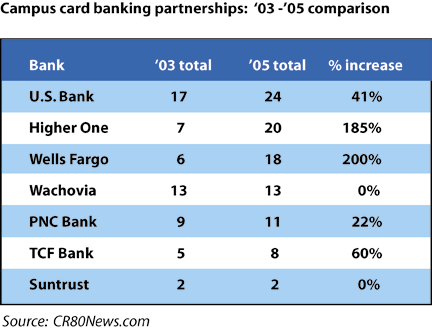
Only one partnership was ended during the period and none were traded between banking partners. Though this survey is not definitive empirical evidence, the astounding lack of turnover seems to suggest that campuses are generally satisfied with their partnerships.
One of the financial institutions, Higher One, has also added a number of campus clients that were not included on the list because they did not fit the strict definition as “campus card banking partnerships.” While these installations did offer financial services via a institution-endorsed card, it was not make use of the official campus ID card. They are, nonetheless, worthy of note. At these institutions, a separate card is issued to enable students and institutions to benefit from the electronic distribution of aid and other payments. These thirteen institutions include: Kennesaw State University, University of West Georgia, Georgia Perimeter College, Texas Woman’s University, Hillsborough Community College, University of North Carolina – Wilmington, Macon State College, Dalton State College, Gordon College, Savannah State University, Spring Arbor University, Siena Heights University, and Aquinas College.
There are a significant, though unknown, number of campuses that have banking partnerships with institutions not included in this survey. For example, Eastern Illinois University partners with First Mid-Illinois Bank & Trust and University of Kansas with Commerce Bank. Many other campuses offer banking services via their campus card in partnership with a local credit union. Thus, this survey is not meant to provide an exhaustive list of bank partnerships but rather suggest a direction and magnitude of the overall trend.
To this end, it seems that the campus card and financial institution partnerships via the ID card are continuing to grow in a positive direction. The following chart summarizes the results of the survey listing the campus card partnerships by bank. If your campus card program has a banking partner and is not included on this list, please take a moment and send us an email so that we can update the list.

 At the recent ASIS security conference, displayed alongside the line of ID card printers in one company’s booth was a big metal locker with a reader and computer attached. It was not what one expects to see amid sleek, footprint-conscious card printers. But according to representatives of the printer manufacturer showcasing it, this box could be one of the most important complements to a card issuing system.
At the recent ASIS security conference, displayed alongside the line of ID card printers in one company’s booth was a big metal locker with a reader and computer attached. It was not what one expects to see amid sleek, footprint-conscious card printers. But according to representatives of the printer manufacturer showcasing it, this box could be one of the most important complements to a card issuing system.
The metal box was actually a safe designed for secure storage and inventory management of blank cards, printer ribbons, and other consumables. It is another step in the important effort to deter fraud and ensure complete accountability for the entire card issuance process. It is an effort that begins with sound business procedures, continues through staff training and evaluation, makes a stop at building security, and continues through network access control. The next stop on the journey involves the protection and control of materials used in card creation.
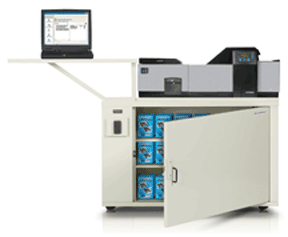 The safe displayed at the conference was offered by printer manufacturer, Fargo Electronics, and is called the SecureVault™. The safe is specifically designed inside to store cards and ribbons in an organized manner. Outside, it is sized to function as a printer stand and has an attachable tray to hold a computer and RFID reader. Access to the SecureVault is controlled by a card reader on its door.
The safe displayed at the conference was offered by printer manufacturer, Fargo Electronics, and is called the SecureVault™. The safe is specifically designed inside to store cards and ribbons in an organized manner. Outside, it is sized to function as a printer stand and has an attachable tray to hold a computer and RFID reader. Access to the SecureVault is controlled by a card reader on its door.
The card reader ensures that only those personnel with specially-issued contactless or proximity access cards can access the safe. A log of this traffic is maintained for security monitoring. An optional inventory management system enables detailed records to be maintained on specific consumables in the vault and the persons that checked out items from the vault. Because most of the company’s consumables ship with RFID tags on the packaging, the optional RFID reader enables items to scanned prior to placement in the vault and automatically entered into the inventory management system. As the items are removed, another quick scan tells the system that the item is being placed into use.
While the SecureVault system seems to be a very versatile and well-designed solution, the message that it conveys may be as important as the product itself. Not all card issuers will deploy a solution such as this, but all issuers should learn from its example. Control of consumables can be accomplished in many ways, some technology-driven and others more basic and immediate.
The low-tech version of the vault and computer-based inventory management system, is the locked drawer and the clipboard. While any organization can certainly do better than this most basic procedure, it is surprising to learn that many do not even take these most rudimentary of protections.
On college campuses, corporate sites, and entertainment venues, I have seen many examples of this. Cards and ribbons are frequently stacked next to the printer in plain view and within reach of card office employees, cleaning crews, and even the general public.
Simple steps such can greatly reduce the likelihood of pilferage and potential fraudulent card creation. If you don’t have a secure location to store your consumables, purchase one or more inexpensive fire safes from a local retailer. Limit access and authorize only a select number of key staff to remove items from the secured location. Keep an accurate log of items as they are checked into and out of inventory.
These are only the most basic of procedures. Other practices are also imperative to maintaining total inventory control. For example, keeping track of bad cards as well as total cards printed reduces the likelihood that missing cards can be “explained away” as misprints.
Better tracking of consumables also leads to better understanding of your supply levels. Perhaps the most common complaint I hear from card suppliers is that customers are always in a rush because they are “running out of cards or on their last ribbon.” Securing your supplies is key to knowing your supplies.
In summary, the safe and careful management of consumables is an essential weapon in the battle against card fraud and it has the added benefit of helping ensure smooth office operation. Whether you employ a high-security solution like Fargo’s SecureVault or simply put common sense procedures into place, this should be established as an immediate goal of your issuance team.
Additional resources:
To learn more about Fargo’s SecureVault offering, click here.
 With the increasing demand for security, access control is an increasingly important campus card function in Europe as it is in the rest of the world. One Spanish company is capitalizing on this rising need with a cost-effective and innovative door control system.
With the increasing demand for security, access control is an increasingly important campus card function in Europe as it is in the rest of the world. One Spanish company is capitalizing on this rising need with a cost-effective and innovative door control system.
Salto Systems, located near Bilbao, Spain, focuses on just one area: building access. Salto can take a college’s existing contactless smart card and, with a few tweaks, make it capable of managing every door on the university’s campus.
Marc Handels, vice president of marketing and sales, said its most well-known clients currently are Cambridge and Oxford universities in the UK. But the company services about 40 colleges, across Europe and in Asia.
Salto’s door control system is ideal for colleges because it doesn’t cost a lot to install, yet it can handle hundreds of doors, said Mr. Handels. Instead of hardwiring every door, or connecting every door to an online system, Salto lets the smart card serve as its “messenger.”
“We have made a bridge,” he explained. “We do online doors, but we limit those to a minimum. Most of the other doors (are controlled by) what we call stand-alone electronic locks. These locks have no wires to a network; so they’ll work on their own. That means installation is cheap.”
Offline doors don’t talk directly to the system. However, with Salto’s virtual network–a bridge between the online and offline doors–the company has found what it calls “the missing link that has always been the difficult part when attempting to manage several hundred doors. Normally, you would have to use a portable programmer and go door-to-door to update the readers,” said Mr. Handels.
Yet, if all those locks are offline and stand-alone, how can one control and manage them in a timely manner? “That’s where the key card technology plays an important role,” said Mr. Handels. “We link the stand-alone doors to the online system. But instead of linking them by hard wires, or having to use a portable programmer to update each door, we let the user’s contactless card update the system for us. Simply by using the card and opening doors, (the user or card) becomes our messenger between the door and system.”
For example, if a student graduates or an employee is terminated, that information is entered into the system. When a card user enters an online door, his card is updated. Then, every time that card accesses an offline door, it updates that part of the system, said Mr. Handels.
“In the case that a card is no longer valid, it gets immediately eliminated. The next time it reaches an online door, it is immediately locked out,” Mr. Handels added. “If that card doesn’t go to an online door, all the other cards will be informed that the card is no longer valid. (Then these cards will ‘spread the news’ to the offline doors through normal use) and the system is updated that way.”
“(Our cards) use several technologies. On the contactless side, we use Mifare, Desfire, ISO 15693 and we’re looking into HID’s iCLASS. We only use high frequency contactless cards that are very secure because the information is kept on the card,” he added.
What makes Salto’s system attractive to universities is that it will work with a college’s existing card program. “We can provide them with a little piece of software that allows them to put the Salto sector on those cards,” said Mr. Handels. “A student can go to the student center and load Salto applications on the (existing) card,” he said.
What about colleges still using mag stripe cards? “We have nothing against mag stripe, except they’re very easy to copy. One of the key elements that has made us so successful with universities is that we use very high security ID media, like contactless smart cards which cannot be copied or cloned,” said Mr. Handels. “If some college still has mag stripe readers, we can provide the university with a contactless smart card with a mag stripe on the back.”
Salto, which recently opened a U.S. office in Atlanta, Georgia, started five years ago “from scratch,” and has since installed some 200,000 doors, said Mr. Handels.
Additional resources:
To visit Salto on the web, click here.
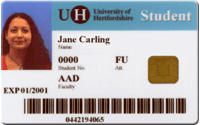 At first glance, card system vendors don’t seem to be as much a part of a European campus programs as they do in the U.S. But look a bit deeper and you will find country or region-specific organizations helping campuses build their programs. According to one such vendor – London-based Fortress GB, – card requirements are often very country-specific. The company’s Smart Campus solution currently services four universities in the UK: University of Hertfordshire, South Bank University, Thames Valley University, and the University of Gloucester.
At first glance, card system vendors don’t seem to be as much a part of a European campus programs as they do in the U.S. But look a bit deeper and you will find country or region-specific organizations helping campuses build their programs. According to one such vendor – London-based Fortress GB, – card requirements are often very country-specific. The company’s Smart Campus solution currently services four universities in the UK: University of Hertfordshire, South Bank University, Thames Valley University, and the University of Gloucester.
According to Natalie Easson, Fortress’ marketing executive, the company expects to add “substantially” more universities in the next year.
Fortress started out with contact-type smart cards for its clients, but that is changing, said Ms. Easson. “A few years ago contactless cards were brand new technology and therefore more expensive than contact cards. As with all technology, things move on and become cheaper. We are now in the process of migrating our Smart Campus clients over to contactless cards.”
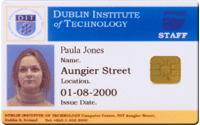 “Each card is preloaded with a wealth of applications (e.g. student ID, time and attendance, credit, debit, logical and physical access, laundry) and self-managed student registration (including online student record update and electronic expiry date). Also electronic voting, as well as an e-purse for use with photocopying, printing, room booking, equipment hire, vending machines, student shops, parking, loyalty schemes and it can integrate with third parties such as transport systems, leisure centers, retailers and so on,” added Ms. Easson.
“Each card is preloaded with a wealth of applications (e.g. student ID, time and attendance, credit, debit, logical and physical access, laundry) and self-managed student registration (including online student record update and electronic expiry date). Also electronic voting, as well as an e-purse for use with photocopying, printing, room booking, equipment hire, vending machines, student shops, parking, loyalty schemes and it can integrate with third parties such as transport systems, leisure centers, retailers and so on,” added Ms. Easson.
Fortress GB also supplies multi-application smart card solutions through its Smart Stadium program. Via tie-ins with the stadium offering, students at Thames Valley can use their Fortress Smart Cards to pay for and enter the Madjeski Stadium for matches and events. “The nature of the pre-loaded applications means that universities can choose which applications to activate at no extra cost as they are already preloaded and ready to go which also means that cards do not have to be recalled or systems changed,” she said. “Being able to introduce third parties to the system gives the additional benefits of new revenue streams for the universities.”
The Smart Omnicard at the University of Hertfordshire incorporates a dual interface chip (with both contact and contactless capabilities), a magnetic stripe and a bar code on the single card. This card enables all of the functions that used to be contained on 5 separate cards: identification, bus passes, an access card, a library and computer card, and an e-purse for use at the university’s shops or in vending machines. Launched in February 1999, there are approximately 20,000 cards for students and student nurses in circulation.
Value is loaded onto the e-purse (contact chip) at the administration center or via an ATM, in return for cash, check or credit card. This value can be used as cash in shops and vending machines or converted to bus tickets or season tickets at self-service Value Transfer Terminals (VTTs) located at various points around the University’s campuses.
Fortress started out in Chip and Pin design and has 15 years’ experience with microchip security design. “Today our solutions are used globally by a diverse array of customers, spanning airlines, football clubs, universities, school and city transport systems. Our Smart Stadium solution has been adopted by leading Premiership football clubs, and at the prestigious 2003 SESAMES Awards, it earned us the award for Best Software,” said Ms. Easson.
Additional resources:
To visit Fortress GB on the web, click here.
To read a case study on the Fortress GB installation at the University of Hertfordshire, click here.
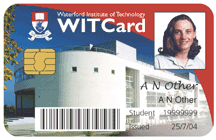 By Andy Williams, Contributing Editor
By Andy Williams, Contributing Editor
Campus card programs in Europe are starting to accelerate, thanks in part to creation in 2003 of the European Campus Card Association. While Europe is often in the forefront of card usage in areas such as transportation and secure payments, it has lagged behind the U.S. when it comes to campus cards.
Eugene McKenna, general manager of auxiliary services for Waterford Institute of Technology in Ireland, and president of ECCA, suggests a possible cause: the 2002 failure of a large campus card company in the U.S., Cybermark, “sent shock waves throughout Europe,” he said. “Adding to that were the failures of several pilot projects in Europe.”
Other sources suggest less reactionary and more pragmatic reasons for Europe’s lag behind the U.S. in campus card implementations. While the desire for administrative efficiencies are common in both regions, key differences traditionally included the U.S. need for financial aid distribution, the more profit-oriented auxiliary service sector in U.S. colleges, and the extreme degree of competition for students that has always existed between institutions in the U.S. Beyond that the sheer size of institutions in the U.S. (e.g. state systems with 60+ schools and 1 million-plus students, individual schools with more than 100,000 students) led to a more lucrative business opportunity for vendors.
But all that seems to be changing as Europe moves more rapidly to campus card solutions. Evidence of this, according to Mr. McKenna, can be found in the growing ECCA membership. Currently at 40 institutions, it is expected “to double in the next few months,” he said. “We’re still in the very early stages.”
He said many university campuses across Europe are starting to introduce campus cards. “They’re becoming an important key at campuses.”
Many, he said, are using magnetic stripe and/or contactless cards linked to a back-end office database. “In Europe there are not many systems where money is stored on the chip. There is no big driver behind that at the moment,” said Mr. McKenna. “The way (European) campuses are wired up, the back office seems suitable to a campus environment.”
Waterford’s WITcard, (www.wit.ie/witcard) serves 10,000 students and is, according to Mr. McKenna, one of the biggest installations in Europe. “Across the UK there are a number of card systems, but there are only two or three applications on each card.”
There was also a tendency among colleges, he added, to go with mag stripe, “but in recent times, Mifare (Philips’ contactless technology) seems to be the technology of choice. We’re using that,” he said of Waterford’s card. Vending, building access, and e-purse, are among the card’s applications. “The latest application is our web revalue where you can load from any bank directly onto our card,” said Mr. McKenna.
Another application, pay-for-print, “is a huge profit center for us,” he added. “Students do a lot of printing off the web. About seven to eight years ago, printing was 25% and copying was 75 % (of total reprographics volume). That has almost reversed itself. There is a huge demand for printing. That’s where a campus card system can generate a profit.”
“All of our card services are managed by auxiliary services. It’s more profitable. I feel we have a very good model unique to us and many of our institutions.”
 Bike sharing programs at university campuses aren’t exactly new. And the one that students at MIT in Boston have been operating for two years isn’t high tech despite its university being synonymous with cutting edge developments.
Bike sharing programs at university campuses aren’t exactly new. And the one that students at MIT in Boston have been operating for two years isn’t high tech despite its university being synonymous with cutting edge developments.
But the goal of these students is to take the program high tech, eventually linking it to MIT’s card program. While the program is called TechBikes, a more accurate term, according to one of its co-founders, Danny Shen, is “a no-tech communal bike” program … at least for now.
“It’s a work in progress,” added Atif Quadir, one of the program’s other co-founders who was a graduate student and an adviser to freshmen in 2003 when the subject of a bike share program came up.
The bike share program brought Mr. Shen, Mr. Quadir, and other students together in 2003 to form a club operated solely by MIT students.
The birth of TechBikes …
“The inspiration was the larger issue of conservation of resources,” said Mr. Quadir. “But the main reason, was that while there are a lot of forms of transportation around MIT – shuttles, the MTA, etc. – there was a gap in transportation services for on-demand and off-campus travel. We have a pretty long campus, about 1.5 to 2 miles, so we felt there was a specific transportation niche that wasn’t being filled.”
A long-term goal is to attach the bike program to the MIT ID card – which is used, like many campus cards, to check out library books and to gain access to dorms and offices. That could encourage greater use of the program, said Mr. Quadir.
Currently, a student goes to the front desk of MIT’s east campus dorm and a staffer signs the student in and loans him a bike. The student pays a nominal deposit that is refundable when the bike is returned. Students must return the bike in a day.
The bike share project is based on the Zip Car program, a national franchise that rents cars by the hour. But the comparison stops there, because Zip Car costs money and it is the goal of MIT’s bike share program to keep it free. Of course that means the club has to seek out sponsors or other grant money.
“We’re applying to get some money from the dorm itself; to buy maintenance materials; we’re also applying to the Deans for money and we’ve submitted an application to the Undergraduate Association, a group of students,” said Mr. Shen, an MIT senior. “We’re seeing if we can get some help from MIT’s transportation department, which covers shuttle buses.”
Said Mr. Shen: “The next step is to introduce some elements of technology and we’re working right now to set up a hub at the athletic center. We have about 20 users right now; we have two to three bikes depending on repairs.”
As to student response to the program, Mr. Shen notes, “we have had some pretty positive responses. It costs them nothing to use the bike. They can email to determine availability. They can rent it for a day.”
The bikes won’t win any beauty contests. “We didn’t want them to be too shiny,” said Mr. Shen, “otherwise they’ll get stolen. He estimates it will take 100 bikes to cover the entire MIT campus. “We figure we’ll need eight to ten hubs, with each hub equipped with four to ten bikes.”
Next steps in the bike share program …
If the first version, the one in use now, is the “no-tech version,” the next iteration could be euphemistically referred to as the “some-tech” version, said Mr. Shen. This is what he’s working on now and involves a computer system in which people are registered. Students will be able to check availability and the club can track rental status and usage. “With that we can get card swipes working with a computer-based system,” said Mr. Shen.
The next version, what Mr. Shen calls the “full-on system,” will be an automated bike checkout station. “Giving you an idea of when that will happen is tough. I know I won’t be around, but we have juniors coming up we can pass the torch down to,” said Mr. Shen.
As to integrating the system with the MIT ID card: “We’ve talked to the card office, generally about what is needed to get their system integrated. And while we know the card office can give us a system that authenticates who the user is, we don’t know if it will tell us if the user is okay and we don’t know whether the registered users end up on our system or theirs.”
He said another possibility, if their system isn’t ideal, is “to set up our own card system. We could register people based on whatever card they have – credit card, MIT card, and issue our own cards.”
The MIT card office weighs in …
Dan Michaud, MIT’s campus card manager, said it would be possible to link TechBikes with the university’s card system. “It depends on what they want to do. Right now we do the Zip Cars, which is handled through the parking office. We have a program where you can create a Zip Car account. Anybody who has an account can be given access to the garage and be able to rent one of the cars, but this is more of a function of our parking and transportation, and the Zip Car account is linked to the person’s credit card.”
Mr. Michaud said there are actually two separate parts that the students should consider: “The financial transaction process and access control.” As to the latter, “the easy way is to put the bike in a room with a card reader.”
Another possibility is to attach a card reader, controlling a solenoid device, to the bike rack. Metal pins would go through the wheel “and if we can get a solenoid to retract those pins, then the system is doable. But you’re creating something that isn’t available now.”
He said students should also be able to go to a web site and type in their id number to check the availability of the bike. The transaction could then be handled through MIT’s TechCash system which debits the student’s account.”
Bottom line, according to Mr. Michaud: TechBikes is feasible. “It’s all eminently doable. You just have to line up the right people.”
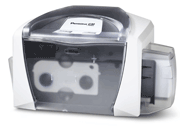 A new low cost, compact card printer from Fargo called the Persona C30 is now available. The C30 is designed for environments needing “high-quality plastic ID cards without high-security features.”
A new low cost, compact card printer from Fargo called the Persona C30 is now available. The C30 is designed for environments needing “high-quality plastic ID cards without high-security features.”
New Persona C30 Card Printer Features Convenience and Simplicity
Single- or Dual-Sided Printer Offers Outstanding Value
Minneapolis, MN (September 9, 2005) – Fargo Electronics, Inc. (NASDAQ: FRGO), a global leader in secure technologies for card identity systems, today announced the introduction of the Persona C30 Card Printer. The Persona C30 is designed for organizations such as K-12 schools, small corporations, clubs or recreation facilities that need high-quality plastic ID cards without high-security features. The C30 will be marketed under the Persona by Fargo brand.
The C30 has been designed with customer convenience in mind. An easy-loading, all-in-one ribbon cartridge saves time and eliminates the mess and expense of torn, wasted ribbons. In addition, a card cleaning roller is integrated into the ribbon cartridge to assure clean card stock and high-quality prints.
With a Manufacturer’s Suggested Retail Price of $2295 for single-sided printing, and $3995 for dual-sided printing, the C30 is an affordable entry-level printer. An optional magnetic stripe encoder is also available.
“The Persona C30 provides performance and reliability in a card printer at a much higher level than its price would suggest,” said Andy Vander Woude, Fargo’s director of product marketing for secure printer/encoders. “With its convenience features and two-year warranty, the C30 is an outstanding value.”
About Fargo
Founded in 1974, Fargo Electronics is a global leader in the development of secure technologies for identity card issuance systems, including secure card printer/encoders, materials and software. The company has sold more than 100,000 systems in the U.S. and over 80 other countries worldwide. Fargo card issuance systems reduce vulnerabilities and potential for loss of time, money and lives by continually improving the security of identity credentials. Fargo provides physical, information and transaction security for a wide variety of applications and industries, including government, corporate, national IDs, drivers’ licenses, universities, schools and membership. Based in Minneapolis, Minn., Fargo markets its products through a global distribution network of professional security integrators. For more information about Fargo, visit www.fargo.com.

